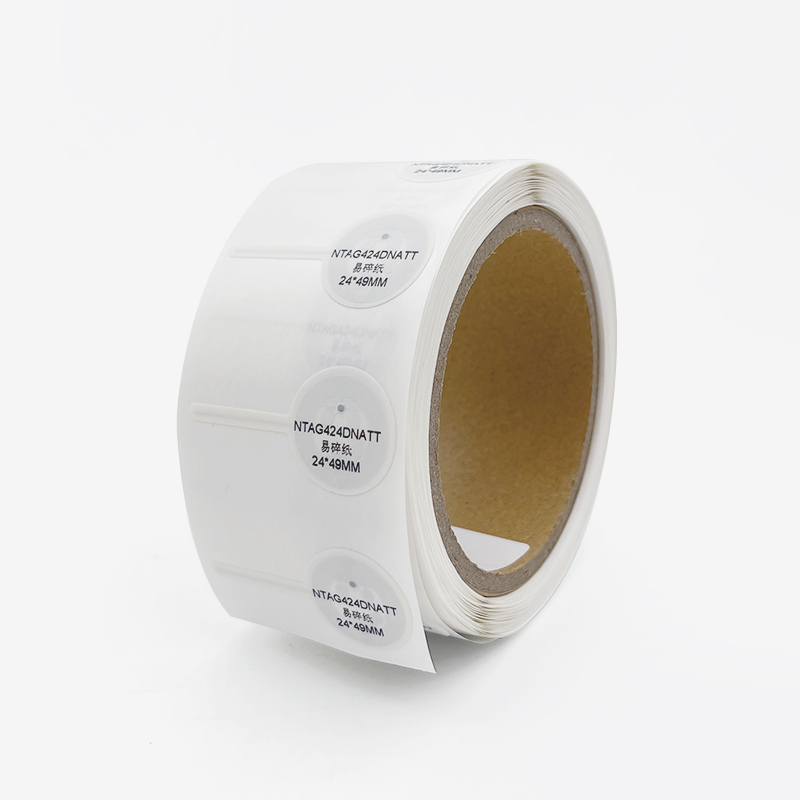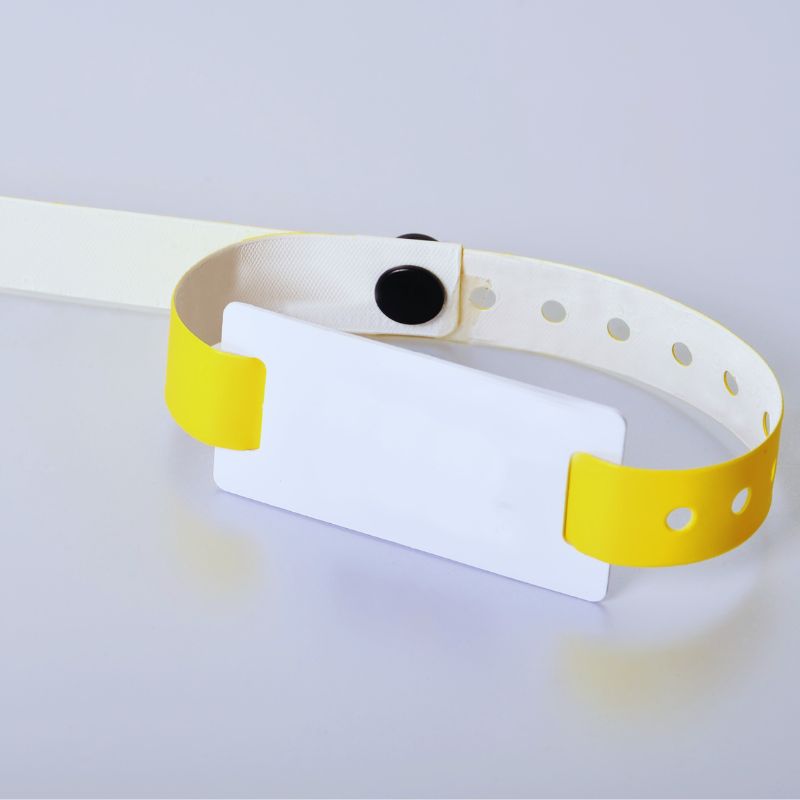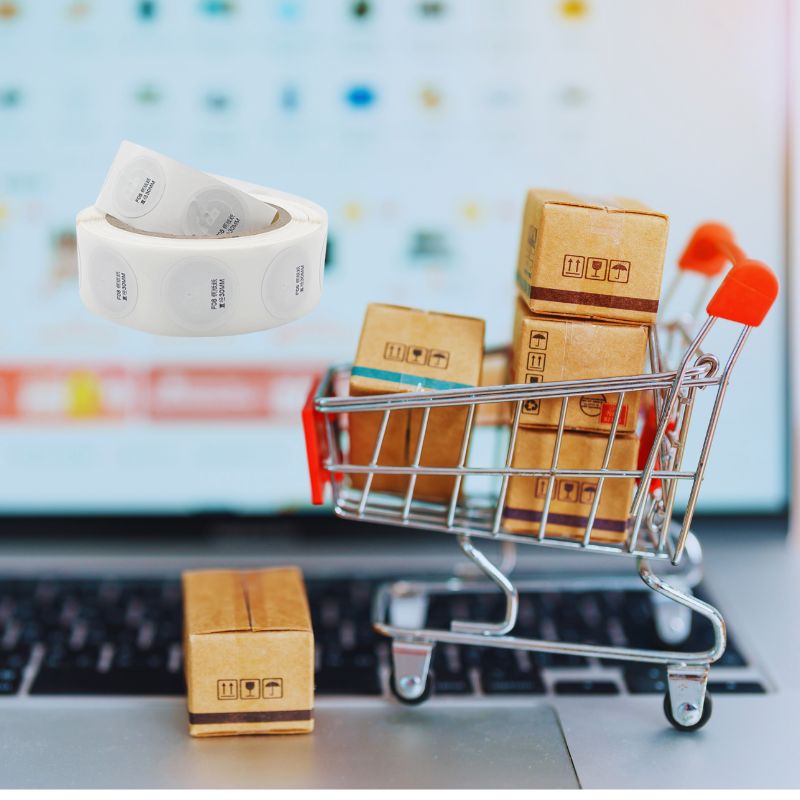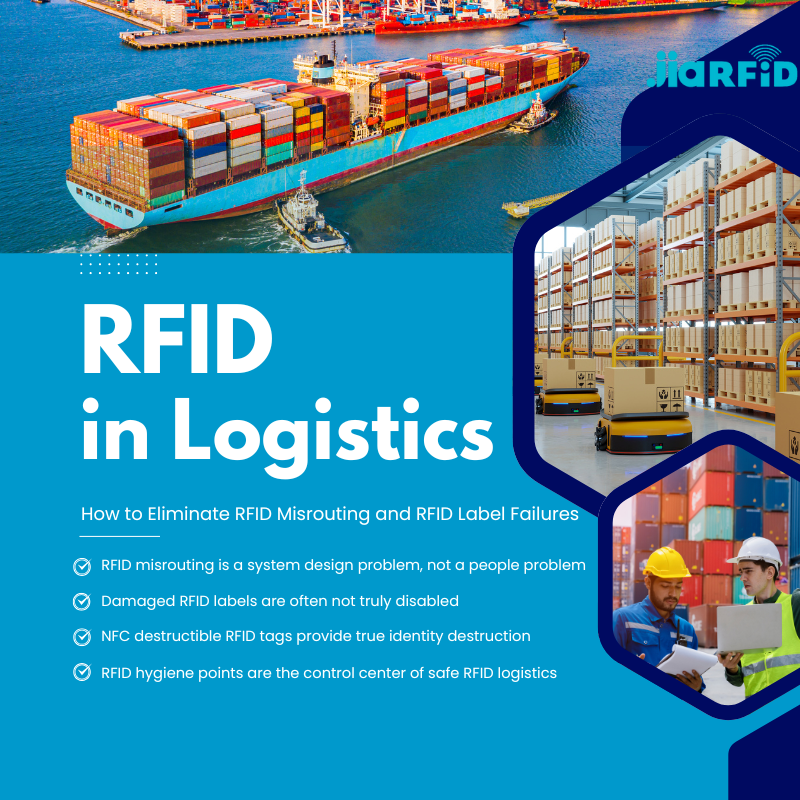
Unlocking Efficiency with RFID Labels & Tags
Table of Contents
RFID Label, Tag, and Beyond: Unlocking the Full Potential of Radio Frequency Identification
This article is worth reading because it goes beyond simple definitions, illustrating how radio frequency identification can revolutionize processes, provide real-time data across industries, and empower you to adopt the technology for better efficiency. Whether in Retail, Logistics and Supply Chain, Transportation and Parking Management, Manufacturing, Healthcare, Asset Management and Security, Agriculture and Livestock Management, or Education and Library Management, the RFID label is key to improved tracking and management. Let me walk you through the exciting world of RFID, discussing label or tag types, the advantages of RFID, and the benefits of RFID labels so that you’ll be inspired to put these insights into practice.

What Is RFID, and How Does It Work?
When we say RFID, we refer to radio frequency identification, a technology that uses radio waves to transmit data and enable tags simultaneously to send information back to the reader without requiring direct line of sight. An RFID system involves an RFID reader, an RFID tag, and a backend infrastructure that processes the data received.
An RFID tag typically includes an RFID chip and antenna. The chip and antenna work together to transmit signals and provide real-time identification or location data about an item. When an RFID label is placed near a reader, the radio waves from the reader activate the chip in the label, allowing it to transmit data back. This differs from a barcode, which requires a line of sight scan. Meanwhile, an inlay is the heart of an RFID label, embedding the necessary components that make RFID possible. Whether you’re dealing with passive RFID tags, active RFID tag, or semi-active tags, the principle remains the same: RFID tags are used to gather data seamlessly and used to track items in real time.
With RFID usage on the rise, it’s no surprise that RFID technology has become vital for inventory management, asset tracking, and other processes throughout the supply chain. The entire RFID solutions ecosystem has evolved so that each label is placed to collect and transmit useful data. Because RFID does not need line of sight to be read, you can automatically capture info even when tags are hidden or embedded, making the technology offers numerous advantages for speed and accuracy in scanning.
Why Choose RFID Label or Tag Over Barcode?
A lot of people wonder: why an RFID label or RFID tag instead of a barcode? Traditional barcode systems are limited by the need for direct line of sight scanning. If items are stacked or mislabeled, barcodes can be easily missed. RFID, on the other hand, can read multiple tags simultaneously from a distance, significantly improving efficiency and accuracy.
Beyond that, RFID labels offer a sturdier solution. Because RFID labels are designed with an RFID chip and antenna, they can transmit item data without wearing out or smudging like traditional labeling. Another big advantage is that a single reader can capture data from multiple tags used in a single sweep, saving time and labor. This enables better inventory management with minimal human intervention.
Furthermore, the benefits of RFID labels go beyond simple identification. They can also store more data than a typical barcode. This data might include manufacturing info, shipping details, or product history, giving you a real-time window into each item. Because of RFID, supply chains gain transparency and speed, while stores can keep more accurate retail inventory records.
What Are the Different Types of RFID Tags?
When planning your RFID project, it’s crucial to understand the types of RFID tags. Generally, RFID tags are a type of label or chip that can be classified into three types:
- Passive Tags: These are powered by the electromagnetic field of the RFID reader. Passive tags do not have an onboard power source; they rely on the radio waves from the reader to activate.
- Active Tags: These contain their own power source (e.g., a battery). An active RFID tag can initiate communication and typically has a greater read range.
- Semi-Active Tags: Often called semi-passive, these combine elements of both. They use a battery for certain functionality but still rely partially on the reader’s electromagnetic field.
For many RFID applications, passive tags are cost-effective and durable, but if you need a longer read range, an active RFID tag might be ideal. Understanding the differences between RFID tags helps you choose the correct RFID solution. The functionality of the RFID tag you pick will determine how data is collected, transmitted data, and stored, so matching the correct RFID tag to your operational needs is essential.
How Do RFID Labels and Tags Enable Real-Time Asset Tracking?
If you’re in industries like Manufacturing, Asset Management and Security, or Agriculture and Livestock Management, you know how important it is to have real-time location and status data. Using an RFID label or RFID tag allows you to gather continuous updates without having to manually scan each item. Because RFID labels can be read from a distance, staff can quickly identify the location of inventory or assets.
This real-time data helps businesses in numerous ways. For example, in retail inventory management, you can automatically track stock levels and reduce the chances of running out of high-demand items. In Logistics and Supply Chain, you can optimize routes and reduce shipping errors, because items are scanned seamlessly across multiple points throughout the supply chain. In Transportation and Parking Management, you can speed up vehicle checks and access control by identifying each car with an RFID pass.
Because RFID labels incorporate an RFID chip and antenna, the item’s ID can be stored, updated, or monitored. This cuts down on human errors while collecting robust data sets. As a result, inventory or asset counts become more accurate, risk of shrinkage is minimized, and data is available in real-time. These tags are ideal for boosting operational efficiency, which is why RFID technology is quickly becoming the industry standard for asset tracking.
Are There Various RFID Applications Across Industries?
Yes! Numerous applications across many sectors utilize RFID. From retail to applications like healthcare, education, and library management, RFID tags are nearly endless. RFID can track patient records, reduce medication errors, or ensure that pricey equipment is always in its designated location in a hospital. Meanwhile, in libraries, librarians can check out multiple books at once just by placing them near an RFID reader.
Think about Transportation and Parking Management: vehicles can be identified in a fraction of a second by scanning an RFID tag on the windshield for access control. In Manufacturing, RFID helps track used to track components along production lines. And in the Agriculture and Livestock Management sector, you can tag cattle or produce shipments to ensure health standards are being met. Indeed, RFID is one of those technologies that touches everyday life without you even noticing.
One fascinating area is the rise of cryogenic RFID labels, which can withstand extremely low temperatures used for advanced medical research or biotech samples. Another interesting development is chemical-resistant RFID labels, perfect for hazardous environments where corrosive substances would damage ordinary tags. In any scenario, RFID has proven to improve data accuracy, provide real-time insights, and reduce costs.
Which Type of Label Is Best for Your RFID Project?
Selecting the type of label that fits your project is crucial. Each label or tag comes with different capabilities based on the type of RFID chosen. For example, a standard RFID label works well in mild environments, but you might need chemical-resistant RFID labels if you handle chemicals. If your process involves extremely cold temperatures—like storing vaccines or biological samples—you’d want cryogenic RFID labels.
Additionally, some operations require more durable or flexible RFID label materials. For instance, items that face rugged handling through shipping and warehousing might benefit from a thicker or protective outer layer. Others might require discreet or small inlay designs for items like apparel in a fashion store. In any case, the best approach is to consider your environment, read range requirements, and any special conditions—like exposure to moisture, extreme temperatures, or mechanical stress.
Using the correct RFID label type ensures that your items remain trackable at all times, eliminating potential downtime or data loss. The better your RFID label adheres to your items, the more reliable your scanning and data collection will be. Sometimes, you can even use smart labels that combine barcode and RFID technology, offering the flexibility to read items either way.
How to Choose the Correct RFID Tag and RFID Printer?
Many modern Android smartphones have built-in NFC hardware, allowing them to function as NFC readers. This capability enables a wide range of applications, from mobile payments and access control to data exchange and smart home automation. To use an Android smartphone as an NFC reader, you typically need to enable NFC in the phone’s settings. Once enabled, the phone can detect and communicate with NFC tags within its range.
Developers can create Android apps that leverage the phone’s NFC capabilities using the Android SDK. The SDK provides APIs that allow apps to read data from NFC tags, write data to tags, and even emulate NFC tags. For example, an app can be programmed to read an NFC tag’s unique ID (UID), retrieve data stored in the tag’s memory, or trigger specific actions based on the tag’s content. Using a smartphone as an NFC reader can be a cost-effective and convenient solution for various applications, particularly those that require mobility or user interaction.
Here is a table summarizing the differences between RFID and NFC:
Finding the correct RFID tag depends on your goals, environmental conditions, and required read range. For instance, if you want to track items over a wide area, consider an active RFID tag with a built-in battery. On the other hand, if cost is a major factor and your items won’t travel far from the RFID reader, a passive RFID approach could be more economical.
You also need the right tools to print and encode your RFID label. An industrial RFID printer is designed to handle large volumes of RFID labels. A specialized RFID printer can encode data onto the chip and antenna of each label, verifying that the RFID label is placed near the reader’s heads properly. Meanwhile, software in your RFID solutions platform ensures that each label is uniquely encoded and that data flows seamlessly to your management system.
Finally, consider the environment in which these items move. Use chemical-resistant RFID labels if the items are exposed to weather or chemicals. If they need to be stored at extremely cold temperatures, use cryogenic RFID labels. Ensuring the right hardware and type of RFID label is the foundation for success.
Do You Need Chemical-Resistant or Cryogenic RFID Labels?
Chemical-resistant RFID labels are vital when operating in industrial settings or labs with corrosive substances. By resisting damage from chemicals, the RFID chip and antenna continue to function, ensuring uninterrupted scanning. If you’ve worked in chemical plants or heavy manufacturing, you know how crucial durability can be.
Meanwhile, cryogenic RFID labels can maintain their structural and functional integrity in sub-zero conditions. Let’s say you’re storing blood samples or biological materials in a deep freeze or cryogenic environment. If you use a standard RFID label, you risk the label becoming brittle or losing adhesion. Cryogenic RFID labels guarantee readability and keep your data accurate, no matter the temperature extremes.
Both types of specialized RFID labels expand RFID usage into environments that were previously off-limits to typical labeling. Because these labels and RFID tags withstand extreme conditions, RFID tracking can continue in highly specialized settings like pharmaceutical research and hi-tech manufacturing.
What Are the Benefits of RFID for Inventory Management and Supply Chain?
Let’s explore the benefits of RFID in inventory management and supply chain operations. One major advantage is efficiency: RFID can scan hundreds of items in seconds. You don’t need a line of sight for scanning, and you can drastically reduce manual labor. This ensures that you have up-to-date info on stock levels, helping you avoid stockouts or overstock situations.
Next, the benefits of RFID labels include accuracy and traceability. Every label stores a unique ID, guaranteeing you know exactly which item you’re dealing with. RFID can also track items throughout the supply chain, from production to shipping and store shelves. This gives logistics managers valuable data to optimize transportation routes and warehouse layouts.
Also, RFID labels enable you to integrate multiple systems, such as your ERP or warehouse management system, so that everything updates in real-time. This real-time data fosters better decision-making, reducing lead times and preventing costly errors. Whether you’re shipping electronics or used for merchandise in a retail setting, RFID helps maintain end-to-end visibility and reliability.
FAQs
How can RFID help in retail inventory management?
RFID is extremely effective in retail inventory management since it identifies items quickly without direct line of sight. This makes counting stock faster, more accurate, and helps with loss prevention. By automating the process, stores can restock shelves and adjust orders promptly.
Do RFID labels and tags allow me to read multiple items simultaneously?
Yes, RFID labels and tags let you scan multiple items simultaneously, often referred to as tags simultaneously scanning. This drastically improves efficiency compared to scanning items one by one using a barcode.
What are some examples of RFID usage?
There are countless examples of RFID implementations. Retailers use RFID labels for retail inventory. Supply chain firms track pallets and shipping containers. Hospitals use them for patient ID and medication tracking. Libraries and schools use them for self-checkout systems. The applications across different environments are vast.
Is RFID suitable for harsh environments like chemicals or low temperatures?
Absolutely. With chemical-resistant RFID labels and cryogenic RFID labels, you can maintain stable RFID functionality even in extreme conditions like corrosive industrial sites or cryogenic freezers. Selecting the type of RFID label specifically designed for these environments is key.
Should I consider custom RFID solutions for specialized needs?
Custom RFID labels or tags might be necessary if you have unique materials, shapes, or environmental factors. A tailor-made approach can ensure the functionality of the RFID tag aligns perfectly with your operational requirements.
How do I begin to adopt the technology for my use case?
Start by consulting with an RFID solutions provider. Determine your process requirements, budget, and environment. Then, select the correct RFID hardware, labels, and software to match. A pilot project is a good way to test real-world performance before scaling up.

Conclusion and Key Takeaways
In wrapping up, I hope you’ve gained clarity on what an RFID label is and how RFID can drastically improve processes across applications across different industries. By choosing the correct RFID tag, implementing a suitable type of RFID label, and making sure you have the right industrial RFID printer, you can confidently undertake an RFID project that transforms your operations.
- RFID stands for radio frequency identification, a technology using radio waves to power and transmit data between a reader and a tag without requiring sight to be read.
- RFID tags are used for inventory management, asset tracking, and supply chain monitoring, providing more efficiency compared to barcodes because of not needing a line of sight.
- There are three types of RFID tags: passive RFID tags, active RFID tags, and semi-active tags, each with a different power source and read range.
- Specialized chemical-resistant RFID labels and cryogenic RFID labels extend RFID usage into harsh or freezing conditions.
- RFID labels are designed to be durable and can incorporate an RFID chip and antenna for quick and accurate data collection.
- Selecting the type of label that meets your environmental and scanning needs ensures you can transmit data reliably.
- RFID labels offer numerous benefits like automated scanning, higher accuracy, and real-time data across inventory management and the supply chain.
- Labels and RFID can also be used for used in applications such as Healthcare, Education and Library Management, or Manufacturing, helping to track items seamlessly.
- To ensure success, partner with an RFID solutions provider who can guide you on the type of RFID, hardware, and integration strategy.
Feel free to reach out to us for more details and see how RFID can elevate your business operations. Our mission is to provide top-notch RFID solutions that accommodate everything from industrial RFID to niche, high-performance requirements.
Comments
Hot Products

RFID in Logistics: How to Eliminate RFID Misrouting and RFID Label Failures
RFID in logistics is more than just a tool to speed up processes. It has become a key part of how modern supply chains operate.

What Is RFID Waste Management
Imagine a city where every trash bin speaks — not literally — but through a tiny chip that tells the system when it’s full, when it’s emptied, and where it went. That’s what RFID waste management is doing today.

What are Bolt Seals and their Applications? | Complete Guide
In global trade and logistics, bolt seals play a crucial role in ensuring cargo security and compliance. These small but powerful devices are designed to lock shipping containers, trailers, and cargo doors with a tamper-evident mechanism.

What is an RFID Card Protector? Benefits, Use Cases, and Buying Guide
RFID technology (Radio Frequency Identification) is everywhere: in your credit cards, ID badges, transit passes, hotel room keys, and more. It offers speed and convenience, but it also opens the door to a new kind of digital theft called “skimming.” That’s where an RFID card protector comes in.

RFID Wristbands for Events: Bulk Buying Guide for Organizers
RFID wristbands for events are becoming the go-to solution for organizers who need faster entry, fraud prevention, and cashless payments at concerts, festivals, and sports venues. Unlike paper tickets or QR codes, these smart wristbands use embedded chips to streamline access, secure transactions, and improve the guest experience.

How RFID Tag on Windscreen Improves Vehicle Access Control and Toll Systems
In today’s fast-paced world, vehicle identification needs to be quick, secure, and contactless. An RFID Tag on the Windscreen provides exactly that — a reliable way to manage toll collection, parking, and gated access without stopping vehicles.
Tags
RELATED BLOGS

RFID in Logistics: How to Eliminate RFID Misrouting and RFID Label Failures
RFID in logistics is more than just a tool to speed up processes. It has become a key part of how modern supply chains operate.

What Is RFID Waste Management
Imagine a city where every trash bin speaks — not literally — but through a tiny chip that tells the system when it’s full, when it’s emptied, and where it went. That’s what RFID waste management is doing today.

What are Bolt Seals and their Applications? | Complete Guide
In global trade and logistics, bolt seals play a crucial role in ensuring cargo security and compliance. These small but powerful devices are designed to lock shipping containers, trailers, and cargo doors with a tamper-evident mechanism.




